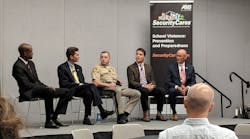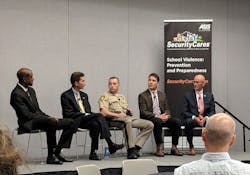Best Practices for Preventing Mass Shootings in Schools
Keeping schools safe from would-be mass shooters requires a multifaceted strategy that brings together facilities professionals, interior designers, school personnel and the community, according to a panel of experts at the 2018 Global Security Exchange (GSX) conference.
(Photo: From left: Sheldon Jacobs, PsyD, a youth and adult intervention specialist with the Clark County Division of Family Services; Scott Breor, deputy assistant secretary with the U.S. Department of Homeland Security Office of Infrastructure Protection; Andrew Walsh, deputy chief of the Las Vegas Metropolitan Police Department; Paul Timm, PSP, vice president of Physical Security Services for Facility Engineering Associates; and Richard E. Smith, vice president at large, IACP, and Chief of Police for the Wakefield, Massachusetts, Police Department.)
Start revamping your security practices with these four common-sense concepts:
1. Access Control
Access control strategies for schools aren’t always about sophisticated technology. Sometimes they’re about reducing the number of ways people can get into your building to do harm and specifying doors that lock from the inside so no one has to step into a dangerous situation during a lockdown.
More GSX coverage: New Hands-Free Access Control for Smartphone
“It begins with access control,” explains Paul Timm, vice president of physical security services for Facility Engineering Associates. “We’ll have more secured vestibules, fewer exterior doors and more interior doors that lock in the classroom. We’ve traded security for convenience, but it’s headed in the right direction now.”
2. Smarter Design
Designing schools requires a strong focus on physical security, but without making the building feel like a jail. Start by looping in students and teachers on what security measures you’re taking and why, Timm recommends.
The entire building should incorporate the principles of Crime Prevention Through Environmental Design (CPTED), a layered approach that emphasizes structuring sites in a way that makes potential criminals uncomfortable and ensures that occupants notice when something is out of place.
Applying CPTED concepts to a school includes four focus areas:
- Natural surveillance: Do you have good lines of sight to see, or is vegetation blocking some views?
- Border definition: Do you have a fence that clearly demonstrates when someone has entered school property?
- Access control and wayfinding: Is it clear where people are supposed to park and enter the building?
- Maintenance: Are you maintaining a clean, orderly campus? When graffiti is created or windows are broken, are they fixed right away or left to send a message that no one is watching the building? Are you leaving any tools in sight that can be used against people in the building?
3. Better Security Policies
Every school needs smart security protocols backing up its technology and design features.
Your state may have requirements for drills. Unfunded security and prevention mandates may require creative budgeting, but letting crucial safety and security requirements fall to the wayside for financial reasons is not an option, says Andrew Walsh, deputy chief of the Las Vegas Metropolitan Police Department.
“Unfunded mandates are killing us. A lot of our communities have old schools that need to be retrofitted, which is a huge challenge to deal with,” adds Richard E. Smith, vice president at large, IACP, and Chief of Police for the Wakefield, Massachusetts, Police Department.
Use NFPA 3000, a new standard designed specifically for responding to active shooters and hostile events, to revamp your emergency planning and response appropriately. Don’t rely only on one standard, however.
Engaging with students is another crucial aspect that has to be customized to each individual school.
“Teach them to maintain situational awareness and know their environment,” says Scott Breor, deputy assistant secretary with the U.S. Department of Homeland Security Office of Infrastructure Protection. “When they walk into a classroom or a hallway, they need to know where they are and think ‘If something was to happen, what would I do?’ as part of their thought process.”
4. Communication Infrastructure
Make the “say something” part of “If you see something, say something” as easy as possible by implementing easy ways for students, faculty and others to report worrisome comments or social media posts.
“We need to show kids that it’s good to say something and you’re not a snitch,” Kevin Child says. “They’re our eyes and ears on this. We need to make sure our kids are speaking up, and they will if you give them an avenue to do so. When you do the right thing, you’re a hero.”
“Sometimes it’s as overt as a kid on social media holding Mom’s gun and saying ‘I’m coming to school strapped tomorrow,’” Walsh explains. “That should prompt an immediate response.”
School resource officers can help monitor social media, Smith says, but students are best positioned to spot questionable behavior since they’re more likely to interact regularly with potential perpetrators.
Tools like Nevada’s SafeVoice app let students report threats anonymously, explains Kevin Child, trustee for District D with the Clark County, NV school district.
“We need to show kids that it’s good to say something and you’re not a snitch,” Child says. “They’re our eyes and ears on this. We need to make sure our kids are speaking up, and they will if you give them an avenue to do so. When you do the right thing, you’re a hero.”
Two handpicked articles to read next:




